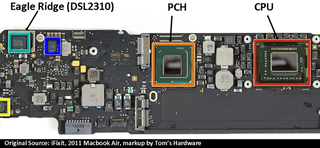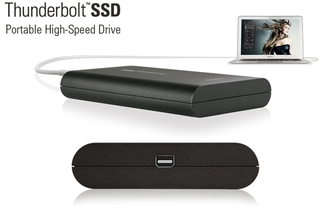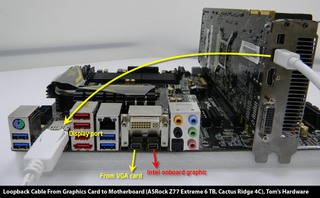Everything You Need To Know About Thunderbolt
Thunderbolt Controllers: Five Flavors, All Intel
Five Flavors, All Intel
Systems supporting Thunderbolt technology are not all created equal. Although Intel currently holds a monopoly on Thunderbolt-capable controllers, the tech is actually available in several flavors.
| Controller Code Name | Model Number | Thunderbolt Channels | DisplayPort | PCIe Interface | Package Size | TDP | Purpose |
|---|---|---|---|---|---|---|---|
| Cactus Ridge 4C | DSL3510L | 4 | 2 outputs | x4 Gen2 | 12 x 12 mm | 2.8 W | PC, Daisy-chainable devices |
| Cactus Ridge 2C | DSL3310 | 2 | 1 output | x4 Gen2 | 12 x 12 mm | 2.1 W | PCs |
| Port Ridge | DSL2210 | 1 | N/A | x2 Gen2 | 6 x 5 mm | 0.7 W | Endpoint devices |
| Light Ridge | CV82524EF/L | 4 | 2 outputs | x4 Gen2 | 15 x 15 mm | 3.2 W | PC, Daisy-chainable devices |
| Eagle Ridge | DSL2310 | 2 | 1 output | x4 Gen2 | 8 x 9 mm | 1.8 W | PCs, Endpoint devices |
| Notes: Bold indicates Second-gen controller |
When Apple originally launched its Sandy Bridge-based Macs, many of them supported Thunderbolt using Intel's Eagle Ridge controller, which enables a single Thunderbolt port, support for one DisplayPort device, and a four-lane PCI Express 2.0 interface to the host platform. If you want to start daisy chaining peripherals, however, you need the more expensive Light Ridge controller, which offers two Thunderbolt ports.

But Intel is not sitting idle. With the introduction of its Ivy Bridge-based platforms, Intel’s partners plan to use a second-generation Thunderbolt controller family referred to as Cactus Ridge that comes in two- and four-channel variants. Because a single port requires two channels, the higher-end 4C model supports two ports, while the 2C SKU enables one Thunderbolt port.
According to Intel's partners, Ultrabooks will employ the single-port Cactus Ridge controller due to its lower power consumption. Enthusiast-oriented desktop systems and daisy-chainable devices will employ the Cactus Ridge 4C for its dual-port support. Both Cactus Ridge parts utilize a four-lane PCIe 2.0 interface. It was previously thought that the 2C version would monopolize two lanes, but we've confirmed that those reports were mistaken.

Intel’s Port Ridge controller is also a second-gen development. However, it's specifically designed to enable Thunderbolt-based endpoints. Devices employing the Port Ridge controller have to be set at the end of your daisy chain (if there is one) or used individually. Elgato’s Thunderbolt-based SSD, a portable 2.5” external SSD with a single Thunderbolt port, is a good example of an endpoint device. And because Thunderbolt delivers up to 10 W of power, you won't have to worry about a separate power cable for products like this one.
Why all of the differentiation in Thunderbolt controllers? Intel is trying to make the technology more affordable where it can. We hear that Light Ridge costs somewhere between $25-$30, and Eagle Ridge supposedly runs around half of that. Port Ridge is, in effect, half of an Eagle Ridge controller, removing Thunderbolt channel used for DisplayPort signaling. Thus, as a single port single channel controller, Port Ridge allows vendors to partially mitigate the expense of enabling Thunderbolt on their end-point devices.
Stay On the Cutting Edge: Get the Tom's Hardware Newsletter
Join the experts who read Tom's Hardware for the inside track on enthusiast PC tech news — and have for over 25 years. We'll send breaking news and in-depth reviews of CPUs, GPUs, AI, maker hardware and more straight to your inbox.
Dual Display Support
The Cactus Ridge 4C and Light Ridge controllers both featuring dual DisplayPort outputs. On the desktop, one pipeline comes from the Sandy or Ivy Bridge-based HD Graphics engine. The other requires interaction with an add-in graphics card. Of course, the option to attach a second screen is important on high-end systems, which is why enthusiast-class Z77 motherboards will feature the four-channel Cactus Ridge controller. Implementation-wise, that's going to look a little strange because you need a DisplayPort loop-back cable between discrete graphics and the motherboard itself. But it's the only way to establish a second path to the Cactus Ridge 4C controller.
"Why not just hook your monitor up to the graphics card, and forget about all of that hassle," you ask? Remember: Thunderbolt uses an active cable.
An active cable allows Thunderbolt to communicate with displays physically farther away without compromising signal integrity. A long DisplayPort cable isn't necessarily a good option because the signal degrades after two meters. DVI uses only passive cables, causing resolution and refresh rate reductions as length increases (that's why DVI boosters exist). Thunderbolt solves those problems and simplifies display connectivity.
| Thunderbolt-Supported Macs | TB Controller | Thunderbolt Ports | Integrated Graphics | Discrete Graphics | Max # Of Connected Displays |
|---|---|---|---|---|---|
| MacBook Air (Mid 2011) | Eagle Ridge | 1 | Y | N | 1 |
| MacBook Pro (13-inch, Early 2011) | Light Ridge | 1 | Y | N | 1 |
| Mac mini (Mid 2011) 2.3 GHz | Eagle Ridge | 1 | Y | N | 1 |
| Mac mini Lion Server (Mid 2011) | Eagle Ridge | 1 | Y | N | 1 |
| MacBook Pro (15- and 17-inch, Early 2011) | Light Ridge | 1 | Y | Y | 2 |
| iMac (Mid 2011) | Light Ridge | 2 | Y | Y | 2 |
| Mac mini (Mid 2011), 2.5 GHz | Light Ridge | 1 | Y | Y | 2 |
Providing that a mobile system with Thunderbolt includes the Light Ridge or Cactus Ridge 4C controller, you can enable dual-monitor output using only integrated graphics. The 13.3" MacBook Pro serves as a good example.
All MacBook Pros feature the Light Ridge controller. On the 15" and 17" MBPs, specifically, Apple does routes a second DisplayPort signal from discrete graphics to the on-board Thunderbolt controller. Yet, the 13.3" model only comes with Intel's HD Graphics 3000. In the case of the smaller MacBook, Apple routes both DisplayPort signals from the integrated graphics subsystem to the Light Ridge controller. The catch is that HD Graphics 3000 only supports two displays. And that's why the 13.3" panel goes blank if you plug in a second 27" Thunderbolt Display.
Ivy Bridge's HD Graphics 4000 engine offers up to three independent displays. So, configurations lacking add-in graphics, but equipped with Light Ridge/Cactus Ridge 4C, still have the potential to drive two Thunderbolt screens without sacrificing the notebook's display.
If your notebook has a Eagle Ridge or Cactus Ridge 2C controller, you can only drive one Thunderbolt display. This is a limitation of the controller, so even if you have discrete graphics, a second Thunderbolt-equipped device cannot be attached.

Technically, it is possible to drive two displays via Thunderbolt using Intel's integrated graphics subsystem on a desktop, but the machine has to meet several requirements for this to happen.
- The motherboard must have a Light Ridge or Cactus Ridge 4C controller.
- Your motherboard must have a DisplayPort input port to route the second display signal.
- You motherboard must have a built-in DisplayPort output port (from Intel HD Graphics 3000/4000), which is looped back to the input port.
Even though it's more work to hook up a loop-back cable, there's a legit reason for its existence. The cable gives you the option to drive a second screen using discrete graphics. Without that, you'd have no way to run a Thunderbolt monitor from a high-performance graphics card.
Current page: Thunderbolt Controllers: Five Flavors, All Intel
Prev Page Thunderbolt's Bandwidth: Sizing Up To USB 3.0, FireWire, And eSATA Next Page Thunderbolt 103: Getting Inside The Controllers-
mayankleoboy1 for more insight of thunderbolt fail and Intel's lying :Reply
http://semiaccurate.com/2012/06/06/intel-talks-about-thunderbolt/ -
shoelessinsight Active cables are more likely to have defects or break down over time. This, plus their high expense, is not going to go over well with most people.Reply -
mayankleoboy1 ^Reply
because "thunderbolt" sounds much sexier than "HDBaseT " ?
and with apple, its all about the sexiness, not functionality/practicality. -
JOSHSKORN Prediction: We will see Thunderbolt available on SmartPhones. When we do, this port will be able to handle a monitor, external hard drives, speakers and many other USB devices through its Thunderbolt docking station. Obviously a SmartPhone won't need to be attached to a webcam. This will become the future desktop...that is, if it can run Crysis. LOL Had to add that in there. :)Reply -
pepsimtl I remenber scsi interface ,so expensive ,just the company (server) use it .Reply
and sata interface replace it.
For me Thunderbolt is the same song
I predict a sata 4 (12gb) or usb 4 ,soon
Most Popular



